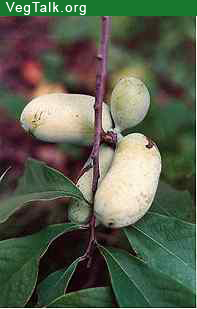
General info about Fruit
Pawpaw (Asimina) is a genus of eight or nine species of small trees with large leaves and fruit, native to eastern North America. The genus includes the largest edible fruit indigenous to the continent. They are understory trees of deep fertile bottomland soils. Pawpaw is in the same family (Annonaceae) as the custard-apple, cherimoya, sweetsop, and soursop, and it is the only member of that family not confined to the tropics.
How to choose a ripe and fresh Fruit
Fruits are very large, averaging 3 pounds in some kinds up to 15 or 20 pounds. Fruit rind is thin, smooth, and rather tender. The pulp is smooth textured and mild flavored. At the center is a cavity, along the walls of which the numerous seeds the size of small peas are borne.
Ways to prepare and serve the Fruit
Edible Parts: Fruit.
Edible fruit - raw or cooked. A very good size, it can be up to 16cm long and 4cm wide. Of variable quality, some forms (with orange skins) are exquisite with the flavour of banana custard whilst others (with yellow, white or dark brown skins) can be unpleasan. Another report says that the white fruits are mildly flavoured and later ripening than the orange fruits. The fruit can also be used for making preserves, pies, ice cream and other sweet desserts. The fruit falls from the tree in autumn and is then stored until fully ripe. The fruit can cause gastro-intestinal upsets for some people.
Health Benefits and Warnings of eating Fruit
Medicinal Uses
Diuretic; Emetic; Laxative; Narcotic; Parasiticide.
The fruit is used as a laxative. The leaves are diuretic. They are applied externally to boils, ulcers and abscesses. The seed contains the alkaline asiminine, which is emetic and narcotic. They have been powdered and applied to hair to kill lice. The bark is a bitter tonic. It contains the alkaline analobine, which is used medicinally.
Other Uses
Dye; Fibre; Insecticide; Wood.
A fibre from the inner bark is used for making strong rope and string. The seed has insecticidal properties. A yellow dye is made from the ripe flesh of the fruit. Wood - light, soft, weak, spongy, coarse grained. It weighs 24lb per cubic foot. It is not used commercially.
Classification
Species
• Asimina angustifolia Raf. - Slimleaf Pawpaw. Florida, Georgia, and Alabama.
• Asimina incana (W. Bartram) Exell - Woolly Pawpaw. Florida and Georgia.
• Asimina obovata (Willd.) Nash - Bigflower Pawpaw. Florida.
• Asimina parviflora (Michx.) Dunal - Smallflower Pawpaw. Southern states from Texas to Virginia.
• Asimina pygmea (W. Bartram) Dunal - Dwarf Pawpaw. Florida and Georgia.
• Asimina reticulata Shuttlw. ex Chapman - Netted Pawpaw. Florida and Georgia.
• Asimina tetramera Small - Fourpetal Pawpaw. Florida EN.
• Asimina triloba (L.) Dunal - Common Pawpaw. Extreme southern Ontario, Canada, and the eastern United States from New York west to southeast Nebraska, and south to northern Florida and eastern Texas.
Recipes made mainly with this Fruit
Composition
In comparison with banana, apple, and orange, pawpaws have a higher protein and fat content. Banana exceeds pawpaw in food energy and carbohydrate content. There is little difference among these fruits in dietary fiber content. Pawpaw is most similar to banana in overall composition. Apple is especially low in protein, orange is low in fat, and both are lower than pawpaw or banana in food energy.
Vitamins
Pawpaw has three times as much vitamin C as apple, twice as much as banana, and one third as much as orange. Pawpaw has six times as much riboflavin as apple, and twice as much as orange. Niacin content of pawpaw is twice as high as banana, fourteen times as high as apple, and four times as high as orange.
Minerals
Pawpaw and banana are both high in potassium, having about twice as much as orange and three times as much as apple. Pawpaw has one and a half times as much calcium as orange, and about ten times as much as banana or apple. Pawpaw has two to seven times as much phosphorus, four to twenty times as much magnesium, twenty to seventy times as much iron, five to twenty times as much zinc, five to twelve times as much copper, and sixteen to one hundred times as much manganese, as do banana, apple, or orange. Sodium content has not yet been determined.
Amino acids
The protein in pawpaw contains all of the essential amino acids. Pawpaw exceeds apple in all of the essential amino acids, and it exceeds or equals banana and orange in most of them.
Fats
The profile of fatty acids in pawpaw is preferable to that in banana. Pawpaw has 32% saturated, 40% monounsaturated, and 28% polyunsaturated fatty acids. Banana has 52% saturated, 15% monounsaturated, and 34% polyunsaturated fatty acids.
Fully ripe pawpaws last only a few days at room temperature, but may be kept for a week in the refrigerator. If fruit is refrigerated before it is fully ripe, it can be kept for up to three weeks, and can then be allowed to finish ripening at room temperature. Ripe pawpaw flesh, with skin and seeds removed, can be pureed and frozen for later use. Some people even freeze whole fruits.